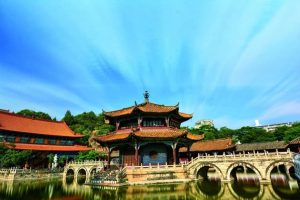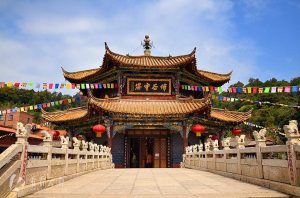Yuantong Temple in Kunming
Yuantong Temple is one of the oldest Buddhist monasteries in Kunming with a history of more than 1200 years. It is also the largest temple in Kunming.
Chinese Name: 圆通寺
Chinese Pinyin: Yuan Tong Si
English Name: Yuantong Temple
Type: Temples, Religions & Landmarks
Best Time: All the year aroud
Recommended Visiting Hours: 1 hour
Opening Hours: 08:00 ~ 18:00
Admission Fee:¥6
Location:on the skirt of the Loufengshan Mountain, also known as Yuantong Mountain, near downtown Kunming
Why is Yuantong Temple so special?
Yuantong Temple is one of the oldest Buddhist monasteries in Kunming with a history of more than 1200 years. It is also the largest temple in Kunming.
Introduction
The History of Yuantong Temple

Style Of Yuantong Temple

Yuantong temple sites have tall spectacular Yuantong Shengjingfang, Yuantong Palace, Octagonal Pavilion and at present the only one Theravada Buddhism of the China mainland—copper buddist hall. The copper Buddha sitting statue inside the hall (3.5 meters high, weighing 4 tons) and Yuantong Palace Sakyamuni statue are in different shapes and show the differences between the two sect of Buddhism. Yuantong Temple looks magnificent, towering and the Buddha is solemn, pavilions are unique, trees are green, attracts generations of poets and painters left many praise verse here, and it has been one of the eight sights of Kunming. Now, after reparation, it shows more its elegant appearance, like a beautiful garden in regions south of the Yangtze River.
Main Attraction in Yuantong Temple
Architecture
The extant buildings include the Yuantong Wonderful Realm (圆通胜境坊), Octagonal Pavilion (八角亭), Yuantong Hall (圆通殿), Copper Buddha Hall (铜佛殿), and etc.
Yuantong Wonderful Realm
This old temple is noted for its unusual structure which is high at the front and low at the back, From the front archway named “Yuantong Shengjing” (Wonderland), one can behold the entire garden.

Yuantong Hall
To the north is the splendid Yuantong main hall. At both sides of the hall are covered corridors running beside clear pools. This structure of a Buddhist hall surrounded by water is unique in China. The main hall maintains the style of the Yuan dynasty architecture. Circling the two central pillars inside the hall are two giant dragons carved during the Ming dynasty. The blue and yellow dragons face each other, as if they are ready to fight.
The stone staircases on both sides of the main hall are carved out of the cliff and are known as the “Caizhilu.” From here one can climb to the top of the mountain. Beside the path are the most ancient inscriptions in Kunming. Weathering in the wind and rain for centuries, the characters are still clear today, and they are one of the most important historical relics in the city.
Behind the main hall are two caves, the “Yougu” and “Chaoying”. The caves wind far into the mysterious depths of the mountain, and, according to local legend, were once the home of dragons. In the Nanzhao Kingdom, a monk built a temple beside the cliff to entice the dragons. When the temple was destroyed, he built a terrace on which to perform magic on the dragons. Sun Ranweng, author and writer of the long antithetical couplet hung on the Daguan Belvedere, used to make a living by predicting people’s fortunes here.
Copper Buddha Hall
In 1982, Thai Buddhists sent a copper statue of Sakymuni to Yuantong Temple as a symbol of friendship, and the statue is three and a half meters high and four tons in weight. A few years later, in 1985, a Copper Buddha Hall was built in a combination of Chinese and Tai styles to house this exquisite gift.
Other Atrractions
Yuan Dynasty Statues
Sakymuni, Amitabha and the Medicine Buddha, all Yuan Dynasty statues, are found in the main hall. The surrounding 500 Buddhist Arhats who are carved in the walls are rare treasures noted for their perfect proportions and lively appearances. Also in this hall are two ten meter high pillars from the Ming Dynasty that are each engraved with a dragon – one yellow and one green – who are trying to extend their bodies and claws into the air as if they are ready to fly. Like the Arhats, they impart the feeling that at any moment they could spring into action.
Stone Staircases

Outside, on each side of the main hall, there are stone staircases that are carved out of the mountainside and wind their way to the top of the hill. As you climb these stairs, there are ancient inscriptions along the way and various tone artworks that are considered the most important historical relics in Kunming. From the top of the stairs, you are presented with a terrific panoramic view of the entire complex. It is from here that you can most appreciate the architecture of the remarkable temple complex.
Buddhist Scriptures
Surrounding the temple pond are a series of halls where you will find old women praying, people sitting and chatting, ongoing classes in Buddhist scriptures, a magnificent calligraphy studio, an exhibit of temple photographs taken at the end of the Qing Dynasty by Auguste de Francois, a shop, a restaurant, and more.
Yuantong Temple is a working temple that also represents the Buddhism of China today. Along with the patronage of the local people of Kunming and Yunnan in general, Buddhists from around the world come here on pilgrimages to pay homage, there are special Buddhist services two times each month, and the Buddhist Association of Yunnan Province is located here. This temple plays a very important role in history and in the modern world.
Nearby Attractions
Yunnan Ethnic Villages
This theme park displays the colorful folklore and architecture of 25 ethnic groups residing in Yunnan Province. The theme park offers shows and performances, folklore and wax museums, as well as replica buildings found in the villages of each ethnic group.
The Western Hills and Dragon Gate
Western Hills boasts an excellent environment with flourishing flowers and dense forest, providing tourists an excellent environment to enjoy the tranquility and marvelous scenery. They have also been given another name – ‘Sleeping Beauty Hills’ for the hills because its skyline looks like a beautiful young lady laying beside Dianchi Lake with her face upward and her hair trailling into water.
The Golden Temple
Golden Temple was built in Ming dynasty and was reconstructed by Wu Sangui in the 10th year of the Kangxi Period (1671 A .D.) made by brass which is the mixture of copper and zinc. That’s why it is named as “the golden temple”. It is totally weighted250 tons and 6.7 meters high; it isthe biggest and heaviest as well as the best preserved copper templein China.
How to Get There
By Subway
Take Subway Line 2 to Chuanxingulou and walk west for about 15mins to the Yuantong Temple.
By Bus
1.Take bus 85, 92, 95, 100, 101, 119, 187, 235 or Z5 to Yuantongjie.
2.Take bus 4, 59, 74, 83, 129, 234, A2, or Z63 to Yuantongshan.
Recommended Yuantong Temple Tours
Top 3 Yuantong Temple tours chosen by most customers to explore Yuantong Temple in the best way. Check the detailed itinerary, or tailor your own trip now with us. We provide some tour routes for tourists to choose.
1 Day Kunming Temples Tour
1 Day Kunming City Discovery Tour
4 Days Best Kunming City Tour with The Stone Forest














